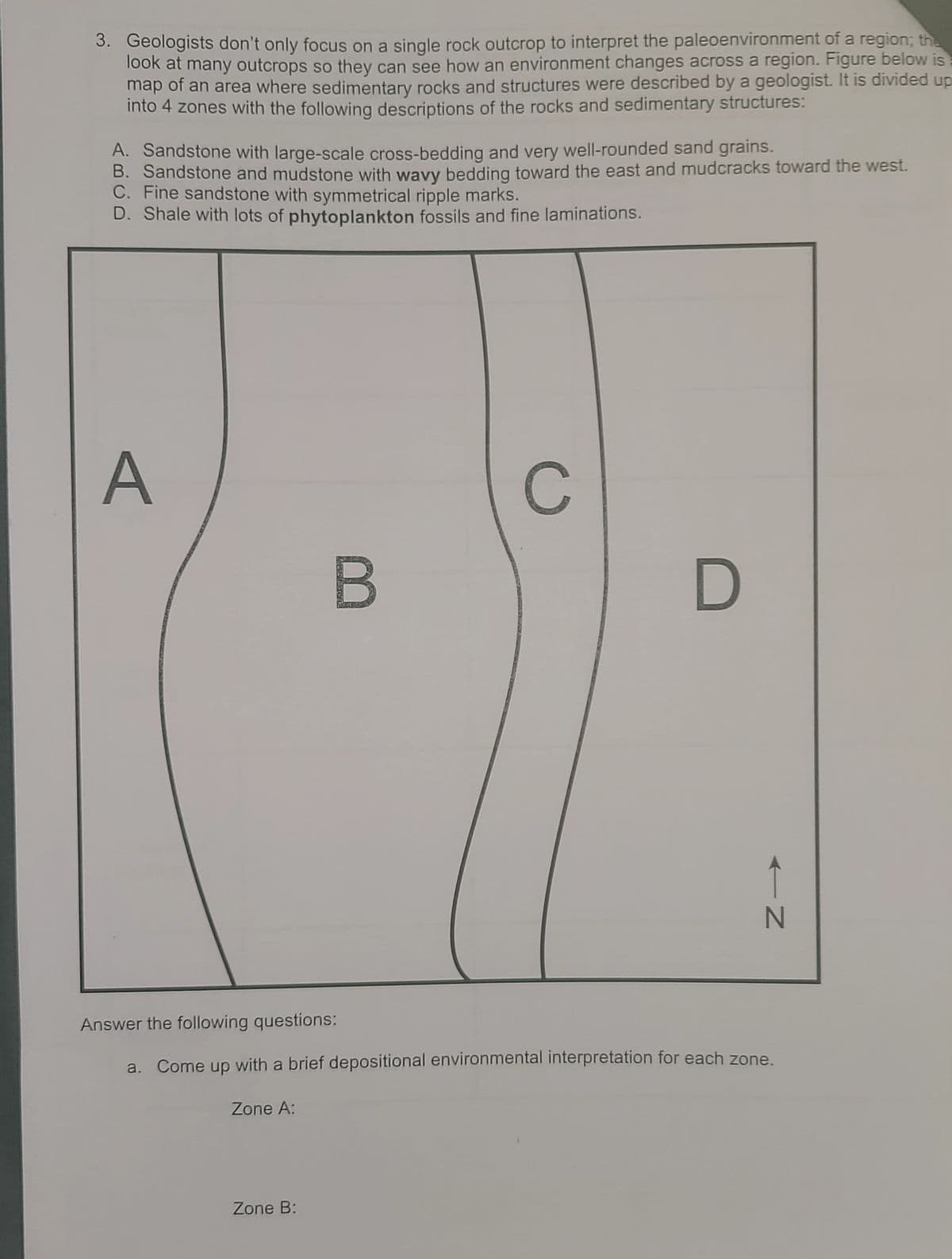3. Geologists don't only focus on a single rock outcrop to interpret the paleoenvironment of a regi look at many outcrops so they can see how an environment changes across a region. Figure E map of an area where sedimentary rocks and structures were described by a geologist. It is di into 4 zones with the following descriptions of the rocks and sedimentary structures: A. Sandstone with large-scale cross-bedding and very well-rounded sand grains. B. Sandstone and mudstone with wavy bedding toward the east and mudcracks toward the we C. Fine sandstone with symmetrical ripple marks. D. Shale with lots of phytoplankton fossils and fine laminations. A Answer the following questions: a. Come up with a brief depositional environmental interpretation for each zone. Zone A: Zone B: C.
3. Geologists don't only focus on a single rock outcrop to interpret the paleoenvironment of a regi look at many outcrops so they can see how an environment changes across a region. Figure E map of an area where sedimentary rocks and structures were described by a geologist. It is di into 4 zones with the following descriptions of the rocks and sedimentary structures: A. Sandstone with large-scale cross-bedding and very well-rounded sand grains. B. Sandstone and mudstone with wavy bedding toward the east and mudcracks toward the we C. Fine sandstone with symmetrical ripple marks. D. Shale with lots of phytoplankton fossils and fine laminations. A Answer the following questions: a. Come up with a brief depositional environmental interpretation for each zone. Zone A: Zone B: C.
Applications and Investigations in Earth Science (9th Edition)
9th Edition
ISBN:9780134746241
Author:Edward J. Tarbuck, Frederick K. Lutgens, Dennis G. Tasa
Publisher:Edward J. Tarbuck, Frederick K. Lutgens, Dennis G. Tasa
Chapter1: The Study Of Minerals
Section: Chapter Questions
Problem 1LR
Related questions
Question
Need help with zones a and b thank you

Transcribed Image Text:3. Geologists don't only focus on a single rock outcrop to interpret the paleoenvironment of a region; the
Took at many outcrops so they can see how an environment changes across a region. Figure below is
map of an area where sedimentary rocks and structures were described by a geologist. It is divided up
into 4 zones with the following descriptions of the rocks and sedimentary structures:
A. Sandstone with large-scale cross-bedding and very well-rounded sand grains.
B. Sandstone and mudstone with wavy bedding toward the east and mudcracks toward the west.
C. Fine sandstone with symmetrical ripple marks.
D. Shale with lots of phytoplankton fossils and fine laminations.
A
↑
Answer the following questions:
a. Come up with a brief depositional environmental interpretation for each zone.
Zone A:
Zone B:
C.
Expert Solution
This question has been solved!
Explore an expertly crafted, step-by-step solution for a thorough understanding of key concepts.
This is a popular solution!
Trending now
This is a popular solution!
Step by step
Solved in 2 steps

Recommended textbooks for you

Applications and Investigations in Earth Science …
Earth Science
ISBN:
9780134746241
Author:
Edward J. Tarbuck, Frederick K. Lutgens, Dennis G. Tasa
Publisher:
PEARSON

Exercises for Weather & Climate (9th Edition)
Earth Science
ISBN:
9780134041360
Author:
Greg Carbone
Publisher:
PEARSON

Environmental Science
Earth Science
ISBN:
9781260153125
Author:
William P Cunningham Prof., Mary Ann Cunningham Professor
Publisher:
McGraw-Hill Education

Applications and Investigations in Earth Science …
Earth Science
ISBN:
9780134746241
Author:
Edward J. Tarbuck, Frederick K. Lutgens, Dennis G. Tasa
Publisher:
PEARSON

Exercises for Weather & Climate (9th Edition)
Earth Science
ISBN:
9780134041360
Author:
Greg Carbone
Publisher:
PEARSON

Environmental Science
Earth Science
ISBN:
9781260153125
Author:
William P Cunningham Prof., Mary Ann Cunningham Professor
Publisher:
McGraw-Hill Education

Earth Science (15th Edition)
Earth Science
ISBN:
9780134543536
Author:
Edward J. Tarbuck, Frederick K. Lutgens, Dennis G. Tasa
Publisher:
PEARSON

Environmental Science (MindTap Course List)
Earth Science
ISBN:
9781337569613
Author:
G. Tyler Miller, Scott Spoolman
Publisher:
Cengage Learning

Physical Geology
Earth Science
ISBN:
9781259916823
Author:
Plummer, Charles C., CARLSON, Diane H., Hammersley, Lisa
Publisher:
Mcgraw-hill Education,